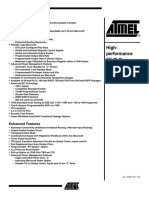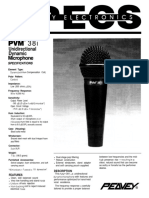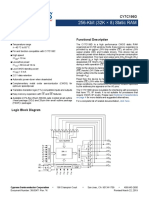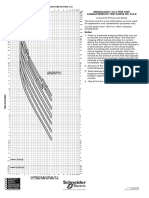Io Pads
Io Pads
Uploaded by
Kislay AnandCopyright:
Available Formats
Io Pads
Io Pads
Uploaded by
Kislay AnandOriginal Title
Copyright
Available Formats
Share this document
Did you find this document useful?
Is this content inappropriate?
Copyright:
Available Formats
Io Pads
Io Pads
Uploaded by
Kislay AnandCopyright:
Available Formats
E C E N 5 2 6 3 D i g i t a l V L S I D e s i g n
I/O Pads
Some way must be provided to get signals to and from the chip. The usual method is to
solder very thin wires directly to the chip. In order to make good electrical contact
between the chip circuitry and the bonding wires, a metal bonding pad must be designed
into the chip circuitry. The bonding pads are usually about 0.1mm on a side and spaced
about 0.1mm between pads. These sizes and spacing are about the same for all processes
regardless of line width since it is extremely difficult to make physical solder joints on
pads that are any smaller. A cutaway of a typical wire bonded package is shown.
bonding wires
chip
package leads
bonding wire
pad
An alternate method of bonding to the pads is to use solder bumps. First a droplet of sol-
der is put on each pad. Then the chip is flipped over and bonded directly to the circuit
board or chip carrier without the use of bonding wires.
solder bump
chip (side view)
(flip)
multi-chip
carrier
I/O Pads September 19, 2005 page 1 of 5
E C E N 5 2 6 3 D i g i t a l V L S I D e s i g n
Fig. 1.61 p. 54 Chip layout with Pad Frame and Power/Ground pads on right side. Note
the large power/ground metal lines for the pad drivers.
Pad frames can be designed for any size chip and any desired number of pads. A pad
frame has been laid out in our 0.6 µm pad library which looks like the following.
5000λ
1500µm
I/O
I/O
I/O
I/O
I/O
I/O
I/O
I/O
I/O
I/O
I/O I/O
I/O 3000λ I/O
I/O 900µm I/O
I/O I/O
I/O GND
VDD I/O
I/O I/O
I/O I/O
I/O I/O
I/O I/O
I/O
I/O
I/O
I/O
I/O
I/O
I/O
I/O
I/O
I/O
All the pads are bidirectional Input/Output pads except for the VDD and GND pads in the
2
middle of the right and left side rows. The internal circuitry must fit into the 3000λ area
inside the frame. This pad frame has 2 power/ground pads and 38 signal pads for a total of
40 pads. All power and ground lines in your design must be connected to the VDD and
GND pads.
I/O Pads September 19, 2005 page 2 of 5
E C E N 5 2 6 3 D i g i t a l V L S I D e s i g n
Output Pads
Pad Driver
(very large)
From To out-
inside side
chip world
Pad Capacitance
(very large)
Drivers: L > Lmin to provide high breakdown voltage, W/L ~ 100 or more to get large
drive current.
Folded layout for drivers makes it possible to have very wide transistors without excessive
gate poly delays.
drain
gate
source
Note that the gates of these transistors present a large gate load to anything trying to drive
them. An intermediate sized inverter buffer is usually provided as part of the pad driver
circuitry to drive the pad drivers while presenting a smaller gate load to the internal cir-
I/O Pads September 19, 2005 page 3 of 5
E C E N 5 2 6 3 D i g i t a l V L S I D e s i g n
cuitry. Because of the large currents flowing in the pad drivers, they are much more sus-
ceptible to latch up than smaller transistors. Guard rings are used around these transistors.
Fig. 12.17 p. 782
Input Pads
Input Buffer
From out- To inside
side chip
world
Pad Capacitance
(very large)
The input buffer usually has very low Vinv to accommodate TTL logic levels (0.8V, 2.0V).
Note that the input pad and buffer present a capacitive load to the outside world. This is
good for preventing any DC load current, but it is bad because large voltages may build up
on the input pad from static electricity until the chip circuitry is damaged. Voltages up to
1000V can be put on the input pin merely by touching an unprotected input with your fin-
ger. Also, the peak electrostatic discharge (ESD) current can be as much as an amp.
~1K
+
1000V
-
ESD Equivalent Circuit for Finger
Input pads must be provided with special circuitry to protect the internal circuitry from
these large voltages and currents.
Input protection Fig. 12.19 p. 783
The diodes keep the input voltage in the range
∠ 0.7V < V in < V dd + 0.7V .
I/O Pads September 19, 2005 page 4 of 5
E C E N 5 2 6 3 D i g i t a l V L S I D e s i g n
Unfortunately, the diodes also increase the capacitive load of the input by a factor of about
2. The parasitic p-n junction diode in the diffusion layers can be used to form the diodes.
Input
Vdd Vdd Vdd
<=>
n+ p+ n+
n-well Input
Input
GND GND
Input
<=>
p+ n+ p+
p-substrate
GND
Tri-state/Bidirectional Pad
Logic for bi-directionality is built into the pad driver. Fig. 12.21 p. 783
The tri-state driver has a clever implementation. Fig. 12.22 p. 783
Typical pad layout (for a 1.6mm process). Fig. 12.23 p. 785
Pad schematic. Fig. 12.24 p. 786
Modern processes operate at low internal voltages compared to the voltage of off-chip sig-
nals. Voltage level converters are often built into the pad driver circuitry.
Fig. 12.25 p. 786
I/O Pads September 19, 2005 page 5 of 5
You might also like
- Manual Alstom S2DADocument50 pagesManual Alstom S2DABagla100% (2)
- HV Cable Size CalculatorDocument7 pagesHV Cable Size Calculatortutti.frutti_virgo9470No ratings yet
- 090826103754preview - SS 546-2009Document5 pages090826103754preview - SS 546-2009atnatc0% (1)
- Egnater SS4 Amp Switcher ManualDocument3 pagesEgnater SS4 Amp Switcher ManualMattNo ratings yet
- PowerFactory EMT Model2Document14 pagesPowerFactory EMT Model2Ratana KemNo ratings yet
- Atf1508 PDFDocument31 pagesAtf1508 PDFPhong DoNo ratings yet
- GalatmelDocument26 pagesGalatmelNacho RomanelloNo ratings yet
- Datasheet G16V8ADocument23 pagesDatasheet G16V8Aj.luis.cf3125No ratings yet
- MAC Quantum Profile Maintenance lvl2 v110Document1 pageMAC Quantum Profile Maintenance lvl2 v110Ahmad ZaiimNo ratings yet
- ATF22V10C DatasheetDocument22 pagesATF22V10C DatasheetfreeeflyerNo ratings yet
- High-Speed Complex Programmable Logic Device ATF750LVC: FeaturesDocument20 pagesHigh-Speed Complex Programmable Logic Device ATF750LVC: FeaturesYaju JotosNo ratings yet
- High-Speed Complex Programmable Logic Device ATF750LVC: FeaturesDocument19 pagesHigh-Speed Complex Programmable Logic Device ATF750LVC: FeaturesEdwin RojasNo ratings yet
- Terminal Overview SystecDocument2 pagesTerminal Overview SystecVentas PesamaticIndustrialNo ratings yet
- MFL68703204 03 Q 01S EngDocument38 pagesMFL68703204 03 Q 01S EngMuhammad AbuHijlehNo ratings yet
- Amlogic S905X S905L GPIO User Guide V0.2-WesionDocument13 pagesAmlogic S905X S905L GPIO User Guide V0.2-WesionGugu ZumzumNo ratings yet
- Ug FC400-EIP QR 1.02enDocument8 pagesUg FC400-EIP QR 1.02enShreya SableNo ratings yet
- Atf16v8cz 15puDocument26 pagesAtf16v8cz 15puatomo atomoNo ratings yet
- Radio Cassette-Corder: WM-GX400Document2 pagesRadio Cassette-Corder: WM-GX400FirmanNo ratings yet
- Manual de Utilizare Modul Adresabil Cu 4 Iesiri Releu Teletek SensoIris MIO04Document2 pagesManual de Utilizare Modul Adresabil Cu 4 Iesiri Releu Teletek SensoIris MIO04vizanteaNo ratings yet
- L202BDocument5 pagesL202Bvinaci2258No ratings yet
- Peavey Micro PVM38Document4 pagesPeavey Micro PVM38Jesús TlacaélelNo ratings yet
- Pal PAL16L8Document21 pagesPal PAL16L8Mark FrenckenNo ratings yet
- PAL16L8AM, PAL16L8A-2M, PAL16R4AM, PAL16R4A-2M PAL16R6AM, PAL16R6A-2M, PAL16R8AM, PAL16R8A-2M Standard High-Speed Pal CircuitsDocument16 pagesPAL16L8AM, PAL16L8A-2M, PAL16R4AM, PAL16R4A-2M PAL16R6AM, PAL16R6A-2M, PAL16R8AM, PAL16R8A-2M Standard High-Speed Pal CircuitsHo PhuNo ratings yet
- Ultrasound Display ModesDocument8 pagesUltrasound Display Modesmisseptember19No ratings yet
- IQ4/IO/..: I/O Expansion ModulesDocument12 pagesIQ4/IO/..: I/O Expansion ModulesRaviNo ratings yet
- ATF2500C CPLD Family Datasheet ATF2500C: FeaturesDocument24 pagesATF2500C CPLD Family Datasheet ATF2500C: FeaturesAngel PardinesNo ratings yet
- 256-Kbit (32K × 8) Static RAM: Features Functional DescriptionDocument16 pages256-Kbit (32K × 8) Static RAM: Features Functional DescriptionMurilo Smse SmseNo ratings yet
- Exchange and Adjustment PLG MHE90K-0xDocument8 pagesExchange and Adjustment PLG MHE90K-0xAdam RaddadiNo ratings yet
- Yadurise Class V 2019 Olympiad Answer KeyDocument1 pageYadurise Class V 2019 Olympiad Answer KeyShivam ZakhmiNo ratings yet
- MODEL 1 7 0 / 2 7 0 / 3 7 0: Weco® "Hammer" Union Pressure TransmuterDocument2 pagesMODEL 1 7 0 / 2 7 0 / 3 7 0: Weco® "Hammer" Union Pressure TransmuterTayeb KaderNo ratings yet
- PF7000 Maintenance Schedule Rev1Document2 pagesPF7000 Maintenance Schedule Rev1LuisNo ratings yet
- Achieving Optimum Results From FM Transmitter Equipment When Using The DAP 310Document7 pagesAchieving Optimum Results From FM Transmitter Equipment When Using The DAP 310allensteel1580No ratings yet
- UOGx ECEg4233 Chapter2xDocument141 pagesUOGx ECEg4233 Chapter2xYayachew MandefroNo ratings yet
- ATF16V8B, ATF16V8BQ, and ATF16V8BQL: FeaturesDocument27 pagesATF16V8B, ATF16V8BQ, and ATF16V8BQL: FeaturesSimilinga MnyongeNo ratings yet
- C Thread Making NR en PDFDocument60 pagesC Thread Making NR en PDFPravin MechNo ratings yet
- Magnum ctv-2922r (ET)Document47 pagesMagnum ctv-2922r (ET)zokiNo ratings yet
- Infineon-CY62148E MoBL 4-Mbit (512 K 8) Static RAM-DataSheet-v20 00-ENDocument20 pagesInfineon-CY62148E MoBL 4-Mbit (512 K 8) Static RAM-DataSheet-v20 00-ENPurple HazeNo ratings yet
- CP1W Mad11 PDFDocument14 pagesCP1W Mad11 PDFimblink100% (1)
- Madulo Analogo Mad 11Document14 pagesMadulo Analogo Mad 11Harol ValenciaNo ratings yet
- User Manual: On-Hold Plus 6500Document12 pagesUser Manual: On-Hold Plus 6500Payphone.comNo ratings yet
- Sidel Motorized Valve Set UpDocument5 pagesSidel Motorized Valve Set UpUsMaN ManzoorNo ratings yet
- Nokia SAR-X ChassisDocument1 pageNokia SAR-X ChassisIrfan AzizNo ratings yet
- Slim Temp IOM109 ADocument1 pageSlim Temp IOM109 Aclaudiodicamillo0221No ratings yet
- Memory DataSheetDocument10 pagesMemory DataSheetNguyễn Ngọc HuyNo ratings yet
- Jazz ™Plc+Hmi Micro-PLC+HMI Installation Guide: JZ20-R10/JZ20-J-R10 JZ20-R16/JZ20-J-R16 JZ20-J-R16HSDocument6 pagesJazz ™Plc+Hmi Micro-PLC+HMI Installation Guide: JZ20-R10/JZ20-J-R10 JZ20-R16/JZ20-J-R16 JZ20-J-R16HSRolando NuñezNo ratings yet
- CY62148EV3Document16 pagesCY62148EV3Dario Gabriel Coz RojasNo ratings yet
- Class Notes Digital Lec11Document2 pagesClass Notes Digital Lec11Asif KishorNo ratings yet
- Casio: Operation Manual Manual Oe OperacionDocument10 pagesCasio: Operation Manual Manual Oe OperacionJohn Carlo Diaz CervantesNo ratings yet
- Cy7c1019cv33 12zcDocument8 pagesCy7c1019cv33 12zcTuhin KarakNo ratings yet
- Honeywell Wi-Fi 9000 Touchscreen Thermostat Installation ManualDocument36 pagesHoneywell Wi-Fi 9000 Touchscreen Thermostat Installation Manualtexastig2347No ratings yet
- 43041515Document68 pages43041515KomtelecNo ratings yet
- Op AmpDocument17 pagesOp AmpHarvizan AlfirkiNo ratings yet
- Instruction Manual: Color TelevisionDocument31 pagesInstruction Manual: Color TelevisionAlphaNo ratings yet
- 1734 In510 - en P PDFDocument12 pages1734 In510 - en P PDFAraik AmbartsumyanNo ratings yet
- OPA350 OPA2350 OPA4350 High-Speed, Single-Supply, Rail-to-Rail Operational Amplifiers SeriesDocument22 pagesOPA350 OPA2350 OPA4350 High-Speed, Single-Supply, Rail-to-Rail Operational Amplifiers SeriesValdir DerlannNo ratings yet
- Master SheetDocument1 pageMaster SheetBalasubraNo ratings yet
- Hybrid 15KW Service Manual 20210820ADocument30 pagesHybrid 15KW Service Manual 20210820AhardvcoreNo ratings yet
- HI Series 350-1200W: Pure Sine Wave Low Frequency Inverter With Built-In AC Battery ChargerDocument5 pagesHI Series 350-1200W: Pure Sine Wave Low Frequency Inverter With Built-In AC Battery ChargerWolfy gacha elamparoNo ratings yet
- De-Energized Tap Changers: Share in All Our Years' Competence, A Quality Tap Changers at Its BestDocument10 pagesDe-Energized Tap Changers: Share in All Our Years' Competence, A Quality Tap Changers at Its BestVictor LeónNo ratings yet
- 1SXU172024L0201 PlutoD20Document2 pages1SXU172024L0201 PlutoD20FaizFzNo ratings yet
- Delta DVP EH2 Instruction SheetDocument19 pagesDelta DVP EH2 Instruction Sheetsatria dhaniNo ratings yet
- KD List AIRIS II-2Document5 pagesKD List AIRIS II-2Rafael Ortega - meajudarafaNo ratings yet
- Performance Analysis of D-Statcom Compensator Using Control Techniques For Load CompensationDocument23 pagesPerformance Analysis of D-Statcom Compensator Using Control Techniques For Load CompensationAmmuRaNo ratings yet
- Breaker Selection and Protection CoordinationDocument5 pagesBreaker Selection and Protection CoordinationVictor Quijano JrNo ratings yet
- Lab External MarksDocument14 pagesLab External MarksiascrackerNo ratings yet
- Helwig-Effect of Spring Pressure On Brush Wear Rate - Nov 08Document8 pagesHelwig-Effect of Spring Pressure On Brush Wear Rate - Nov 08Rohan KallaNo ratings yet
- DuFlex Flexible CablesDocument23 pagesDuFlex Flexible CablesAli FarooqNo ratings yet
- MicrocontrollerDocument7 pagesMicrocontrollerThangarajan NagarajanNo ratings yet
- 4E Sci Phy Chapter 18 - Practical Elec - TRDocument48 pages4E Sci Phy Chapter 18 - Practical Elec - TRXu JianhangNo ratings yet
- E08 Handbook LedDocument13 pagesE08 Handbook LedlaekemariyamNo ratings yet
- Micrologic Trip CurvesDocument3 pagesMicrologic Trip Curves322399mk7086No ratings yet
- Datasheet Micro Solenoid Valve Series v367 v03b Asco en 5377170Document2 pagesDatasheet Micro Solenoid Valve Series v367 v03b Asco en 5377170jackzhang7608No ratings yet
- Magnet Presentation - EMT PhysicsDocument24 pagesMagnet Presentation - EMT PhysicsletsjoyNo ratings yet
- Complinace CBD Towers Scope (SM6)Document26 pagesComplinace CBD Towers Scope (SM6)Li LiuNo ratings yet
- Overcurrent & Overload Protection 0 265V: MZ 1 1 - 05 P 70R H 265Document3 pagesOvercurrent & Overload Protection 0 265V: MZ 1 1 - 05 P 70R H 265Tio Junior e Henrique HérculesNo ratings yet
- Specification of Lightning Protection Based On BSEN 62305Document8 pagesSpecification of Lightning Protection Based On BSEN 62305Ayman SaberNo ratings yet
- High Frequency Function Generator With The Maxim MAX038Document11 pagesHigh Frequency Function Generator With The Maxim MAX038JCNo ratings yet
- Eme Unit 5 NumericalsDocument13 pagesEme Unit 5 NumericalsKartik PandeyNo ratings yet
- SC15G Universal Compressor R134a 220-240V 50/60Hz: GeneralDocument2 pagesSC15G Universal Compressor R134a 220-240V 50/60Hz: GeneralSergiu RusuNo ratings yet
- P82C150 Serial Linked I/O (SLIO) Device: Application NoteDocument52 pagesP82C150 Serial Linked I/O (SLIO) Device: Application NoteJim LiebNo ratings yet
- 1 Detector PrincipleDocument11 pages1 Detector PrincipleAmir KhaleghiNo ratings yet
- Nem8 (Kia7042)Document4 pagesNem8 (Kia7042)sanjud16No ratings yet
- Electrical Data: General Data:: Data Sheet For Three-Phase Squirrel-Cage-MotorsDocument1 pageElectrical Data: General Data:: Data Sheet For Three-Phase Squirrel-Cage-MotorsJEDPNo ratings yet
- Hysteresis Loop Tracer.: TitleDocument7 pagesHysteresis Loop Tracer.: TitleSubhrajit SamantaNo ratings yet
- Graphene Field Effect Transistor As Radiation DetectorDocument6 pagesGraphene Field Effect Transistor As Radiation DetectorDaljeet Singh MottonNo ratings yet
- IAT2 Question Paper AMEDocument5 pagesIAT2 Question Paper AMEbalaji sivaNo ratings yet
- Low Power Inverter For Domestic ApplicationsDocument39 pagesLow Power Inverter For Domestic ApplicationsNarendhar Mudavath100% (1)
- Cost Analysis and Comparison of HVAC, LFAC and HVDC For Offshore Wind Power ConnectionDocument7 pagesCost Analysis and Comparison of HVAC, LFAC and HVDC For Offshore Wind Power Connectionrk_mbdNo ratings yet
- V Guard Wires CablesDocument16 pagesV Guard Wires CablesRitesh TyagiNo ratings yet

























































































